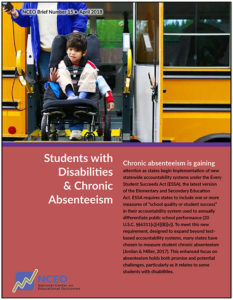 NCEO recently published a Brief on Students with Disabilities and Chronic Absenteeism. The 2015 reauthorization of the Elementary and Secondary Education Act (ESEA), as the Every Student Succeeds Act (ESSA), requires states to include one of more school quality or student success measures in their accountability system. Many states have selected chronic absenteeism as their school quality measure. This Brief contains information about chronic absenteeism and possible implications for students with disabilities.
NCEO recently published a Brief on Students with Disabilities and Chronic Absenteeism. The 2015 reauthorization of the Elementary and Secondary Education Act (ESEA), as the Every Student Succeeds Act (ESSA), requires states to include one of more school quality or student success measures in their accountability system. Many states have selected chronic absenteeism as their school quality measure. This Brief contains information about chronic absenteeism and possible implications for students with disabilities.
Elementary school students with disabilities who have an IEP are 1.5 times as likely as elementary students without disabilities to be chronically absent, while secondary students with disabilities with an IEP are 1.4 times as likely as other students to be chronically absent. According to the U.S. Department of Education:
- Children who are chronically absent in preschool, kindergarten, and first grade are much less likely to read on grade level by the third grade.
- Students who cannot read at grade level by the third grade are four times more likely to drop out of high school.
- By high school, regular attendance is a better dropout indicator than test scores.
- A student who is chronically absent in any year between the eighth and twelfth grade is seven times more likely to drop out.
The Brief contains recommended actions for states to consider if they are using chronic absenteeism as an accountability measure:
- Develop a clear definition of “chronic absenteeism.”
- Consider the “stakes” of the metric for “chronic absenteeism” for schools or students.
- Make communication with parents a priority.
- Encourage districts and schools to discover the root cause of absenteeism.
- Examine data at deep levels.
- Recommend that schools consider the need for an IEP meeting when absences are clearly connected to the student’s disability.
- Provide a clear message to districts and schools that they should provide services to compensate for lost instructional time.
- Monitor schools and districts’ heightened use of in-school suspensions.
- Identify for consideration and adoption proven dropout prevention programs that benefit students with disabilities.
- Implement enhanced attention to chronic absenteeism carefully, ethically, and professionally.
The Brief also contains links to several related resources:
Chronic absenteeism: Recognizing child find obligations
Chronic absenteeism and students with disabilities: Frequently asked questions
